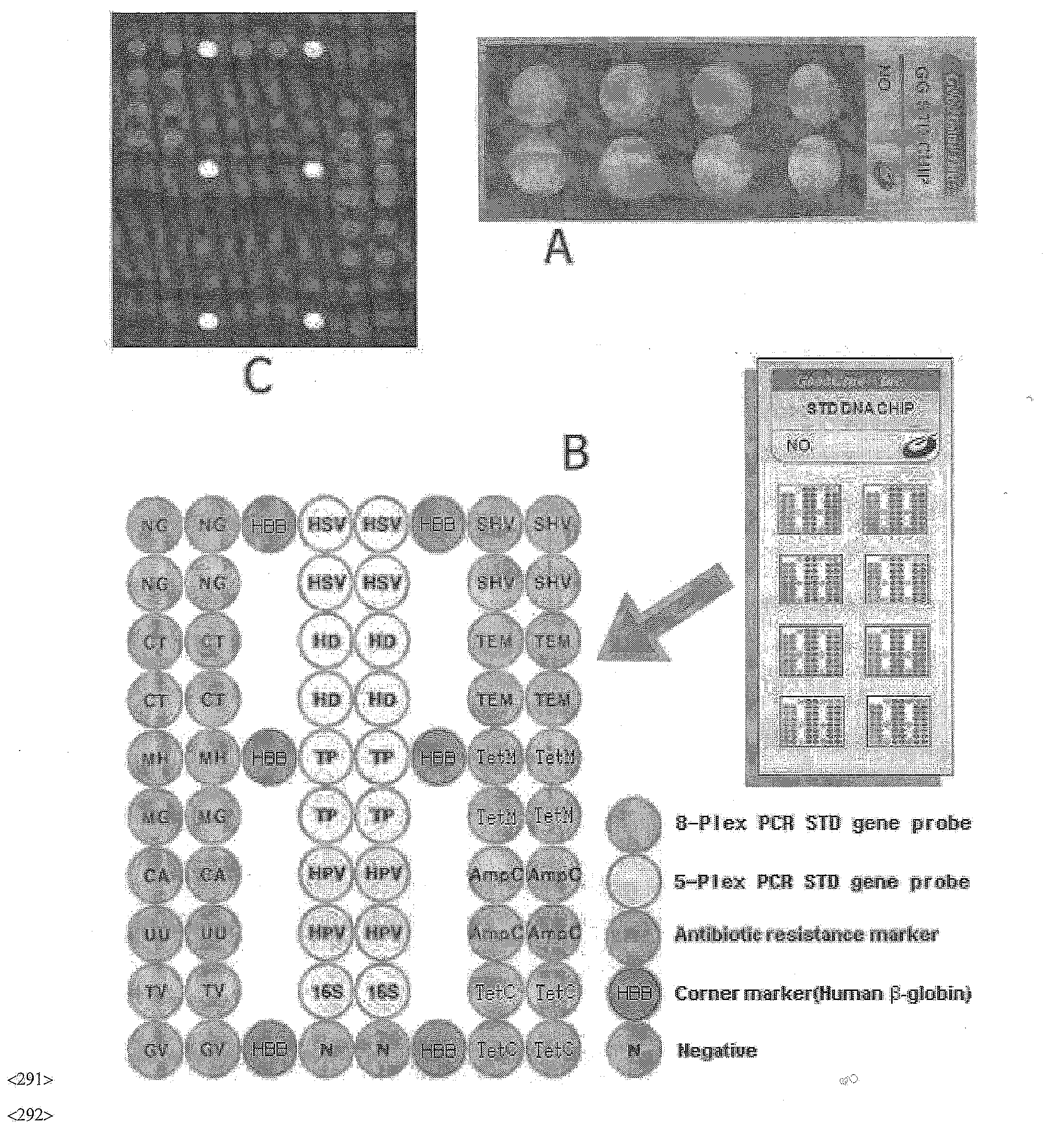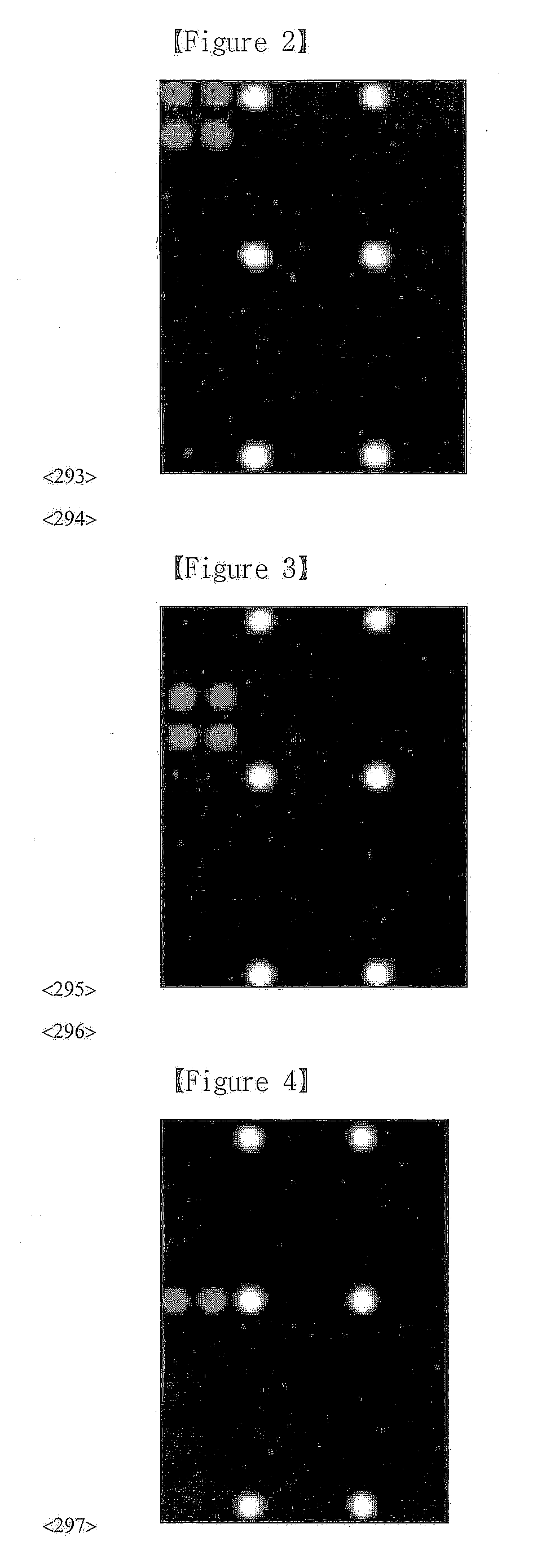DNA chip, kit for detecting or genotyping bacteria causing sexually transmitted diseases, genotyping antibacterial drug resistance and detecting or genotyping method using the same
a technology for detecting or genotyping bacteria and kits, applied in the field of dna chips and kits, can solve the problems of inapplicability, time, cost and labor, and many restrictions of traditional diagnosis techniques, and achieve the effects of convenient and easy to interpret, quick and accurate detection of infection, and accurate detection of complicated infections
- Summary
- Abstract
- Description
- Claims
- Application Information
AI Technical Summary
Benefits of technology
Problems solved by technology
Method used
Image
Examples
example 1
Design of PCR Primer
[0115]The success in amplification of nucleic acids, especially by PCR, depends on whether a primer specifically anneals only with its target sequence. Whether a primer specifically anneals only with its complete complement or it anneals also with other nucleotide sequences with one or more mismatch(es) depends on annealing temperature.
[0116]In general, at higher annealing temperature, the possibility of specific annealing with a perfectly matching template increases. Therefore, the odds of amplification of the target sequence increases. In contrast, at lower annealing temperature, amplification of non-target sequences increases as mismatch tolerance increases. Thus, by controlling the annealing temperature, the pairing characteristics between the template and the primer may be varied. For example, if a product is formed in a control group having only one primer, it means that the primer anneals with more than one site of the template. In that case, it is recomme...
example 2
Securement of Control Microorganism and Sample and Clone Thereof
[0123]The strains of the 14 STD-causing microorganisms of standard positive control group and DNAs of antibiotic resistance genes were purchased from ATCC (Manassas, Va. 20108, USA, and also, a sample which had been identified to be already infected with each microorganism and a sample including antibiotic resistance genes were obtained. DNA was isolated therefrom, and then the target gene region to be assayed was amplified by PCR for each microorganism and identified through cloning and sequencing. Plasmid clone was secured for each of them.
[0124]The cloning experiment was performed by the publicly known method as follows. The method for PCR is the same in following examples, so the description thereof is skipped here.
[0125]1) The PCR products of the genes of the 14 STD-causing microorganisms and the PCR product of human beta-globin gene were isolated on the agarose gel using a gel recovery kit (Zymo Research, USA), an...
example 3
Gathering of Clinical Sample
[0134]A suitable method was established for gathering from a human body various samples such as discharge from the urethra, cervix or mouth, a swab sample which is obtained by gathering cells with a cotton swab or brush, the urine, urethral washing solution and the prostate solution, and carrying and storing them before an assay. Gathering of the male urine was performed in division of VB (voided bladder) 1, VB2 and VB3 expressed prostatic secretion (EPS) according to the traditional 3-glass test. VB1 refers to the 10 to 20 mL urine which comes first in urination, i.e., early stream urine. VB2 refers to mid-stream urine which comes in the middle of urination. The EPS refers to secretion which comes to the urethra following the prostate massage. VB3 refers to the 10 to 20 mL urine which comes first in urination following the prostate massage. Herein, VB1 represents a urethra sample, VB2 represents a bladder sample, and VB3 represents a prostate sample.
[013...
PUM
| Property | Measurement | Unit |
|---|---|---|
| time | aaaaa | aaaaa |
| temperature | aaaaa | aaaaa |
| volume | aaaaa | aaaaa |
Abstract
Description
Claims
Application Information
 Login to View More
Login to View More - R&D
- Intellectual Property
- Life Sciences
- Materials
- Tech Scout
- Unparalleled Data Quality
- Higher Quality Content
- 60% Fewer Hallucinations
Browse by: Latest US Patents, China's latest patents, Technical Efficacy Thesaurus, Application Domain, Technology Topic, Popular Technical Reports.
© 2025 PatSnap. All rights reserved.Legal|Privacy policy|Modern Slavery Act Transparency Statement|Sitemap|About US| Contact US: help@patsnap.com



